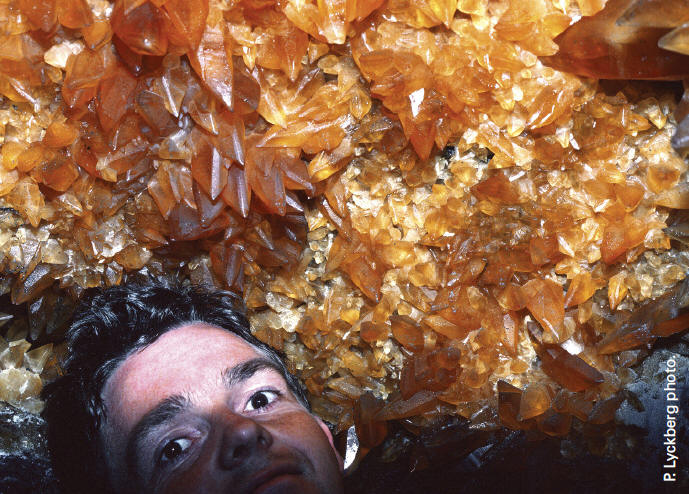
The author in the Butterfly Twin Pocket, 1989. Malmberget mine, Sweden.
One of the least known finds ofworld class minerals in Europe wasmade in an iron mine in the polar regionof northernmost Sweden two decadesago. The Malmberget mine located nearG?llivare, Lappland, Sweden has produceda number of well crystallized mineralssince the end of the 19th century.
Since the 1980’s, numerous exceptionalspecimens have been found, and the authorwas fortunate to participate inthe extraction of many of the crystals.
Credit for the preservation of specimensduring several decades of mining goesto miner Kenneth Holmgren. Of coursethis was only possible because of the positiveattitude toward collecting held bythe mining company – LKAB.
In 1982 a pocket with exceptionalgreen fluorites was found and then in1988-89 two extraordinary pockets withgolden calcite crystals were discovered.
Specimens from these finds are very rareon the market and at the same timehighly sought-after by mineral collectorsaround the world.
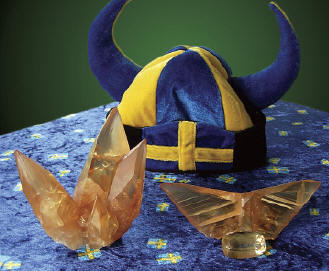
Vikings “helmet” and tablecloth in Swedish flag motif. Two specimens and cut stone are among the best from the find. P. Lyckberg specimens and photo.
GEOLOGYNorthern Sweden has several of theworld’s largest and richest magmatic magnetite deposits. The magmatic originof these large sheet like ore bodies hasonly been confirmed by geologists withinthe last 30 years. The largest of theseiron ore deposits occur at Kiruna,Malmberget and Svappavaara. The Malmberget(Ore Mountain) deposit differsfrom the others due to the presence ofwell crystallized mineral species. Theeuhedral crystal growth can be attributedto metamorphism and associatedskarn mineralization as well as tectonicmovement which all combined to formextensive cavity systems that were idealloci for crystal development during latestage mineralization.
The Malmberget deposit is hostedby Precambrian volcanics which weresubjected to at least two metamorphicevents yeilding gneisses. The gneisses were intruded by sheet-like magmaticapatite-magnetite bodies. Intrusion ofthe magnetite bodies was followed bygranitic and pegmatitic intrusions whichoverprinted skarn mineralization on themagmatic deposit. Late stage hydrothermalfluids were probably responsible for abundant solution cavities that werethen filled by fluorite, calcite, hematite,and stilbite crystals. Folding relatedto metamorphism modified the initialsheet-like magnetite body into semiirregular,discontinuous bodies occurringover a 6 km long zone. The main ore zone consists of 14 separate ore bodies,with several smaller bodies lateral to themain zone.
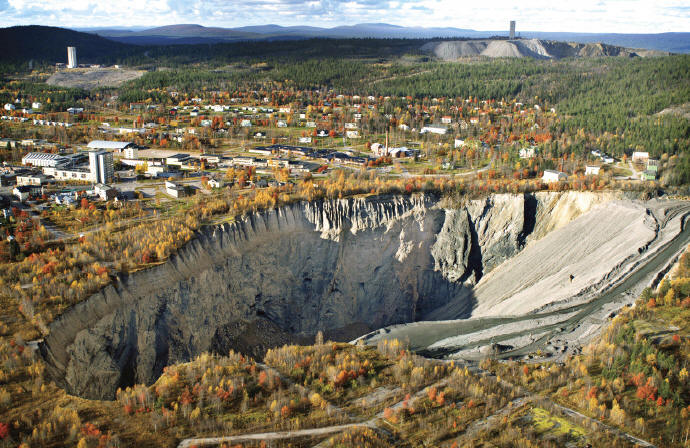
One of the open pits at the edge of Malmberget town. Main shaft and dumps from recent mining activity is seen at the upper left horizon. LKAB photo.
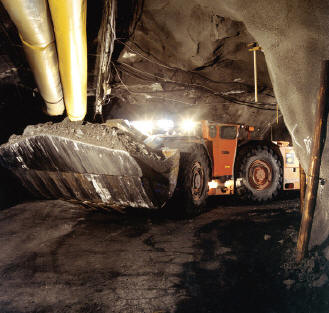
LHD mine vehicle underground in the Malmberget mine corridors. LKAB photo.
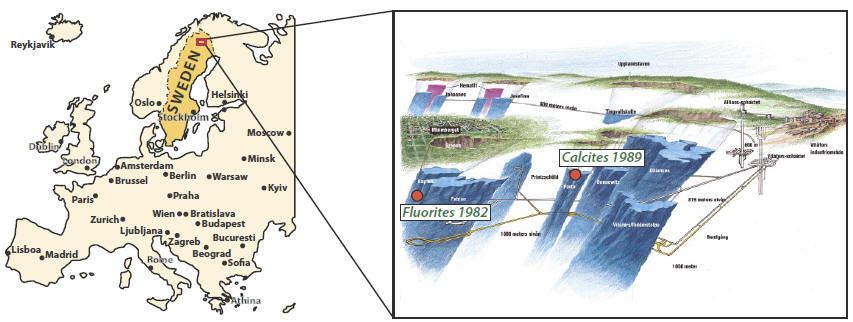
Map of Europe outlining the region around the Malmberget mine. Insert of modified cross-section shows mine location, main orebodies and sites of fluorite and calcite finds described in the text. Drawing by LKAB.
HISTORY
Malmberget Mountain rises abovethe deep forests of the polar region ofnorthern Lappland. Magnetite depositswere known here as early as the 17th century.
Mining at that time was sporadicdue to sparse population of the Lap(Sami) people whose primary existencecentered around reindeer herding. Earlytransportation of ores to the coast wasdone on sledges pulled by reindeer.
In 1888 a railroad was completedfrom the coastal town of Lule? up to themining area which allowed for the startup of large scale mining. The mine wasinitially operated as an open pit. As easilyaccessed ores were depleted at thesurface, underground mining commenced.
Underground mining is presently down to the 1000 m level. As of 2006more than 500,000,000 metric tonnes ofore have been produced, placing it secondonly to Kiruna in production.
Beautiful crystals and rich pocketswere known from the early days of mining,but surprisingly few specimens werepreserved. A few old specimens can beseen at the Museum of Natural Historyin Stockholm, and there are records ofexchanges with overseas museums. Additionally,specimens were sold by themining company. As early as the 1960’sthe mining company was open to tourists(a policy still in effect today), and souvenirspecimens were made available tovisitors. My first exposure to mineralsfrom Malmberget come from samplescollected by my grandparents who touredthe mine in 1966.

Collecting one of the pockets in the Malmberget mine. B. Morgenstern photo.
SWEDISH MINERAL SHOWSAND A FEW MALMBERGETSPECIMENS IN 70’S
Sweden’s first mineral show tookplace in 1977 in the old traditional miningcenter of Kopparberg in the southcentralpart of the country. There werestill many working mines at that time.
Miners and collectors came from all overSweden, and a few people broughtspecimens from northern Lappland. Oneminer brought a whole flat of almost perfect groups of scalenohedral, lightyellow to light honey colored calcite crystals.
They were collected from a longpocket located in the roof of an accesstunnel at Malmberget. These crystalswere at the time, the finest ever fromSweden. Later in the 1970’s, some averageto very fine specimens appeared atshows, but only in very small quantities.
These were principally fluorapaites, stilbites,calcites, hornblendes, pyrites andbyssolite.
As a young teenager, I had no lucktrying to buy a single crystal as thewhole flat was already reserved for“a big dealer” from Stockholm. The dealerbought the whole lot as an investment,and stashed them away (it wasdecades later when they finally madeit to market!). From that day on, the search has been on to find superb Malmbergetcalcite specimens…








 YueGongAnBei 44051102000467
YueGongAnBei 44051102000467


 |
|